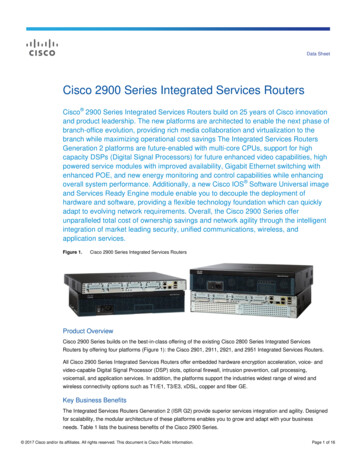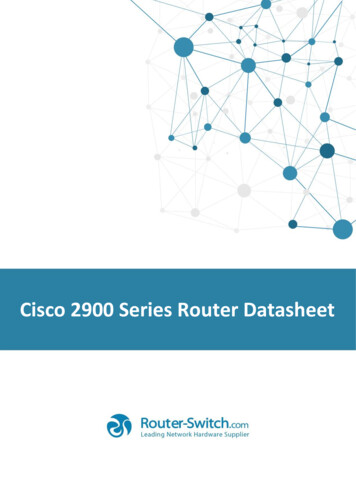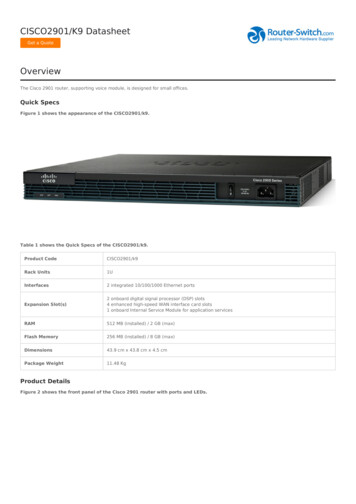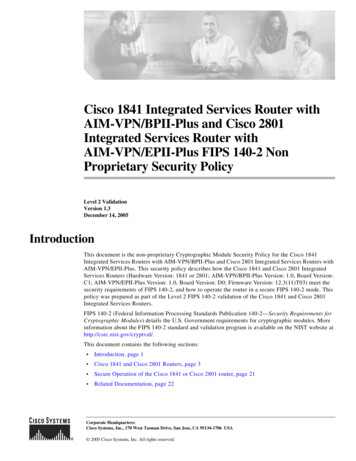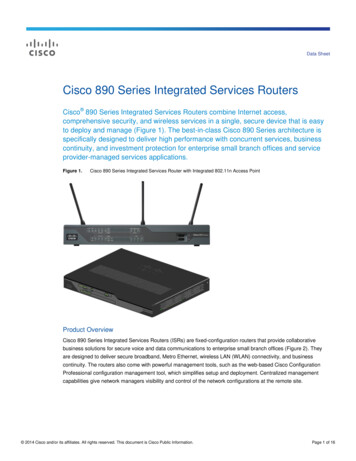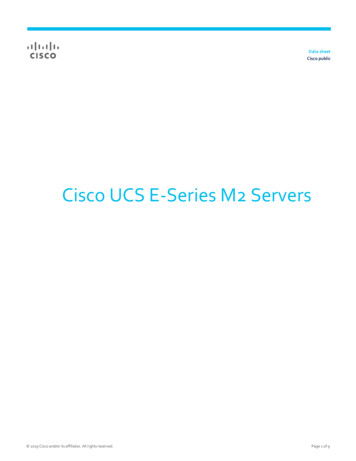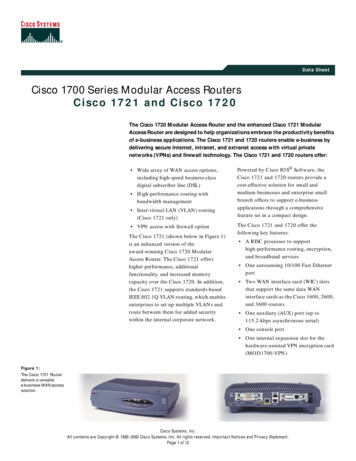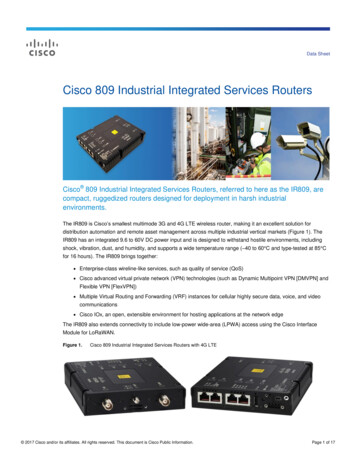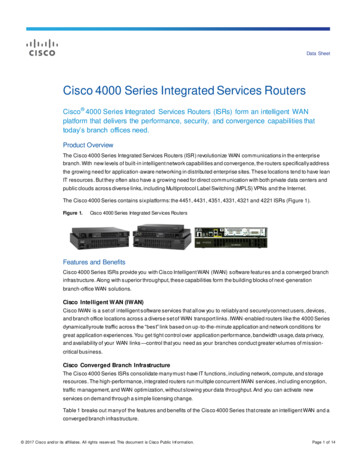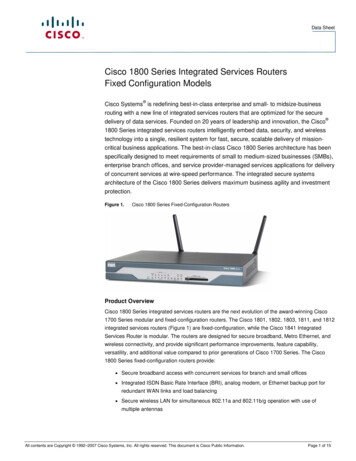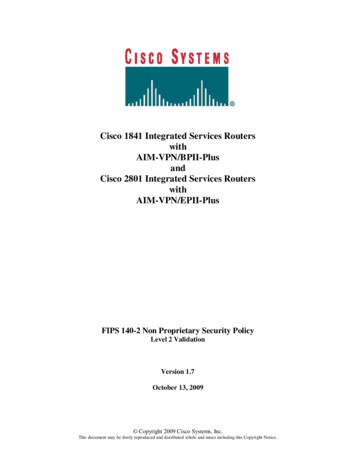
Transcription
Cisco 1841 Integrated Services RouterswithAIM-VPN/BPII-PlusandCisco 2801 Integrated Services RouterswithAIM-VPN/EPII-PlusFIPS 140-2 Non Proprietary Security PolicyLevel 2 ValidationVersion 1.7October 13, 2009 Copyright 2009 Cisco Systems, Inc.This document may be freely reproduced and distributed whole and intact including this Copyright Notice.
Table of Contents1INTRODUCTION . 31.11.21.31.4PURPOSE . 3REFERENCES . 3TERMINOLOGY . 3DOCUMENT ORGANIZATION . 32 CISCO 1841 AND 2801 ROUTERS . 52.1 THE 1841 CRYPTOGRAPHIC MODULE PHYSICAL CHARACTERISTICS . 52.2 THE CISCO 2801 CRYPTOGRAPHIC MODULE PHYSICAL CHARACTERISTICS . 72.3 ROLES AND SERVICES . 112.3.1. User Services . 112.3.2 Crypto Officer Services . 112.3.3 Unauthenticated Services . 122.3.4 Strength of Authentication . 122.4 PHYSICAL SECURITY . 132.5 CRYPTOGRAPHIC KEY MANAGEMENT . 172.6 SELF-TESTS . 262.6.1 Self-tests performed by the IOS image . 262.6.2 Self-tests performed by Onboard FPGA . 262.6.3 Self-tests performed by AIM . 273SECURE OPERATION OF THE CISCO 1841 OR 2801 ROUTER . 283.1 INITIAL SETUP . 283.2 SYSTEM INITIALIZATION AND CONFIGURATION . 283.3 IPSEC REQUIREMENTS AND CRYPTOGRAPHIC ALGORITHMS . 293.4 PROTOCOLS . 293.5 SSLV3.1/TLS REQUIREMENTS AND CRYPTOGRAPHIC ALGORITHMS. 293.6 REMOTE ACCESS . 29 Copyright 2009 Cisco Systems, Inc.2This document may be freely reproduced and distributed whole and intact including this Copyright Notice.
1Introduction1.1 PurposeThis document is the non-proprietary Cryptographic Module Security Policy for the Cisco 1841and 2801 Integrated Services Routers with AIM-VPN/BPII-Plus installed. This security policydescribes how the Cisco 1841 and 2801 Integrated Services Routers (Hardware Version: 1841 or2801; Firmware Version: IOS 12.4 (15) T3 and 12.4 (15) T10) meet the security requirements ofFIPS 140-2, and how to operate the router in a secure FIPS 140-2 mode. This policy wasprepared as part of the Level 2 FIPS 140-2 validation of the Cisco 1841 or 2801 IntegratedServices router.FIPS 140-2 (Federal Information Processing Standards Publication 140-2 — SecurityRequirements for Cryptographic Modules) details the U.S. Government requirements forcryptographic modules. More information about the FIPS 140-2 standard and validation programis available on the NIST website at http://csrc.nist.gov/groups/STM/index.html.1.2 ReferencesThis document deals only with operations and capabilities of the 1841 and 2801 routers withAIM modules in the technical terms of a FIPS 140-2 cryptographic module security policy.More information is available on the routers from the following sources:The Cisco Systems website contains information on the full line of Cisco Systemsrouters. Please refer to the following ters/index.htmlFor answers to technical or sales related questions please refer to the contacts listed onthe Cisco Systems website at www.cisco.com.The NIST Validated Modules ation.html) contains contact informationfor answers to technical or sales-related questions for the module.1.3 TerminologyIn this document, the Cisco 1841 or 2801 routers are referred to as the router, the module, or thesystem.1.4 Document OrganizationThe Security Policy document is part of the complete FIPS 140-2 Submission Package. Inaddition to this document, the Submission Package contains:Vendor Evidence documentFinite State MachineOther supporting documentation as additional references Copyright 2009 Cisco Systems, Inc.3This document may be freely reproduced and distributed whole and intact including this Copyright Notice.
This document provides an overview of the routers and explains their secure configuration andoperation. This introduction section is followed by Section 2, which details the general featuresand functionality of the router. Section 3 specifically addresses the required configuration forthe FIPS-mode of operation.With the exception of this Non-Proprietary Security Policy, the FIPS 140-2 ValidationSubmission Documentation is Cisco-proprietary and is releasable only under appropriate nondisclosure agreements. For access to these documents, please contact Cisco Systems. Copyright 2009 Cisco Systems, Inc.4This document may be freely reproduced and distributed whole and intact including this Copyright Notice.
2 Cisco 1841 and 2801 RoutersBranch office networking requirements are dramatically evolving, driven by web and ecommerce applications to enhance productivity and merging the voice and data infrastructure toreduce costs. The Cisco 1841 and 2801 routers provide a scalable, secure, manageable remoteaccess server that meets FIPS 140-2 Level 2 requirements. This section describes the generalfeatures and functionality provided by the routers. The following subsections describe thephysical characteristics of the routers.2.1 The 1841 Cryptographic Module Physical CharacteristicsFigure 1 – The 1841 router caseThe 1841 Router is a multiple-chip standalone cryptographic module. The router has aprocessing speed of 240MHz. Depending on configuration, either the installed AIM-VPN/BPIIPlus module or the internal Giove FPGA or IOS software is used for cryptographic operations.The cryptographic boundary of the module is the device’s case, shown in Figure 1. All of thefunctionality discussed in this document is provided by components within this cryptographicboundary.The interface for the router is located on the rear panel as shown in Figure 2.Figure 2 – Rear Panel Physical InterfacesThe Cisco 1841 router features a console port, an auxiliary port, Universal Serial Bus (USB)port, two high-speed WAN interface card/WAN interface card/Voice interface card(HWIC/WIC/VIC) slots, two 10/100 Fast Ethernet RJ45 ports, and a Compact Flash (CF) drive. Copyright 2009 Cisco Systems, Inc.5This document may be freely reproduced and distributed whole and intact including this Copyright Notice.
The 1841 router supports AIM-VPN/BPII-Plus card and two fast Ethernet connections. Figure 2shows the rear panel. The front panel contains 2 LEDs that output status data about the systemstatus (SYS OK) and system activity (SYS ACT). The back panel consists of 8 LEDs: twoduplex LEDs, two speed LEDs, two link LEDs, CF LED and AIM LED.The rear panel contains the following: (1) Power inlet (2) Power switch (3) HWIC/WIC/VIC slot 0 (4) Console port (5) FE ports (6) Lock (7) HWIC/WIC/VIC slot 1 (8) CF drive (9) CF LED (10) AIM LED (11) USB port (12) Auxiliary port (13) Ground connectorThe following tables provide more detailed information conveyed by the LEDs on the front andrear panel of the router:NameStateDescriptionSystem OKSolid GreenRouter has successfully booted up and thesoftware is functional.Booting or in ROM monitor (ROMMON)mode.System is actively transferring packets.System is servicing interrupts.No interrupts or packet transfer occurring.Blinking GreenSystem ActivitySolid GreenBlinking GreenOffTable 1 – 1841 Front Panel IndicatorsNameStateDescriptionAIMSolid GreenSolid OrangeOffAIM installed and initialized.AIM installed and initialized error.AIM not installed.Compact FlashSolid GreenIndicates that the flash is busy and should notbe removed.OK to remove flash card.OffTable 2 – 1841 Rear Panel IndicatorsThe following table describes the meaning of Ethernet LEDs on the rear panel:NameState Copyright 2009 Cisco Systems, Inc.Description6This document may be freely reproduced and distributed whole and intact including this Copyright Notice.
DuplexSpeedLinkSolid GreenOffSolid GreenOffSolid GreenOffFull-DuplexHalf-Duplex100 Mbps10 MbpsEthernet link is establishedNo link establishedTable 3 – 1841 Ethernet IndicatorsThe physical interfaces are separated into the logical interfaces from FIPS 140-2 as described inthe following table:Router Physical Interface10/100 Ethernet LAN PortsHWIC/WIC/VIC PortsConsole PortAuxiliary PortUSB port10/100 Ethernet LAN PortsHWIC/WIC/VIC PortsConsole PortAuxiliary PortUSB Port10/100 Ethernet LAN PortsHWIC/WIC/VIC PortsPower SwitchConsole PortAuxiliary Port10/100 Ethernet LAN Port LEDsAIM LEDSystem OK LEDSystem Activity LEDCompact Flash LEDConsole PortAuxiliary PortUSB PortPower PlugFIPS 140-2 Logical InterfaceData Input InterfaceData Output InterfaceControl Input InterfaceStatus Output InterfacePower InterfaceTable 4 – 1841 FIPS 140-2 Logical InterfacesThe CF card that stored the IOS image is considered an internal memory module, because theIOS image stored in the card may not be modified or upgraded. The card itself must never beremoved from the drive. Tamper evident seal will be placed over the card in the drive.2.2 The Cisco 2801 Cryptographic Module Physical Characteristics Copyright 2009 Cisco Systems, Inc.7This document may be freely reproduced and distributed whole and intact including this Copyright Notice.
Figure 3 – Cisco 2801 router caseThe 2801 router is a multiple-chip standalone cryptographic module. The router has a processingspeed of 240MHz. Depending on configuration, either the installed AIM-VPN/BPII-Plus moduleor the internal Giove FPGA or the IOS software is used for cryptographic operations.The cryptographic boundary of the module is the device’s case, shown in Figure 3. All of thefunctionality discussed in this document is provided by components within this cryptographicboundary.The interfaces for the router are located on the front and rear panel as shown in Figure 4 andFigure 5, respectively.Figure 4 – 2801 Front Panel Physical InterfacesFigure 5 – 2801 Rear Panel Physical InterfacesThe Cisco 2801 router features a console port, an auxiliary port, Universal Serial Bus (USB)port, two high-speed WAN interface card (HWIC) slots, Voice interface card (VIC) slot,WIC/VIC slot, two10/100 Fast Ethernet RJ45 ports, and a Compact Flash (CF) drive. The 2801router has two slots for AIM-VPN/BPII-Plus cards 1, two internal packet voice data modules(PVDMs), and two fast Ethernet connections. Figure 4 and Figure 5 show the front and readpanels of the router. The front panel consists of 14 LEDs: two duplex LEDs, two speed LEDs,1The security policy covers the configuration in which one AIM card is used. Copyright 2009 Cisco Systems, Inc.8This document may be freely reproduced and distributed whole and intact including this Copyright Notice.
two link LEDs, two PVDM LEDs, two AIM LEDs, system status LED (SYS OK), systemactivity (SYS ACT) LED, inline power LED, and CF LED. The back panel has the power inletand on/off switch.The front panel contains the following: (1) VIC slot (2) HWIC/WIC/VIC slot 0 (3) WIC/VIC slot (4) HWIC/WIC/VIC slot 1 (5) Console port (6) FE ports (7) System status and activity LEDs (8) Inline power LED (9) USB port (10) FE LEDs (11) Auxiliary port (12) CF LED (13) CF driveThe rear panel contains the following: (1) Power inlet (2) Power switch (3) Ground connectorThe following tables provide more detailed information conveyed by the LEDs on the front andrear panel of the router:NameStateDescriptionSystem OKSolid GreenRouter has successfully booted up and thesoftware is functional.Booting or in ROM monitor (ROMMON)mode.Inline power supply is working properly.Inline power failure.Inline power supply is not present.System is actively transferring packets.System is servicing interrupts.No interrupts or packet transfer occurring.Indicates that the flash is busy and should notbe removed.OK to remove flash card.PVDM1 installed and initialized.PVDM1 installed and initialized error.PVDM1 not installed.PVDM0 installed and initialized.PVDM0 installed and initialized error.PVDM0 not installed.AIM1 installed and initialized.Blinking GreenInline PowerSystem ActivityCompact FlashPVDM1PVDM0AIM1Solid GreenAmberOffSolid GreenBlinking GreenOffSolid GreenOffSolid GreenSolid OrangeOffSolid GreenSolid OrangeOffSolid Green Copyright 2009 Cisco Systems, Inc.9This document may be freely reproduced and distributed whole and intact including this Copyright Notice.
AIM0Solid OrangeOffSolid GreenSolid OrangeOffAIM1 installed and initialized error.AIM1 not installed.AIM0 installed and initialized.AIM0 installed and initialized error.AIM0 not installed.Table 5 – 2801 Front Panel IndicatorsThe following table describes the meaning of Ethernet LEDs on the front panel:NameStateDuplexSolid GreenOffSolid GreenOffSolid 100 Mbps10 MbpsEthernet link is establishedNo link establishedTable 6 – 2801 Ethernet IndicatorsThe physical interfaces are separated into the logical interfaces from FIPS 140-2 as described inthe following table:Router Physical Interface10/100 Ethernet LAN PortsHWIC/WIC/VIC PortsConsole PortAuxiliary PortUSB Port10/100 Ethernet LAN PortsHWIC/WIC/VIC PortsConsole PortAuxiliary PortUSB Port10/100 Ethernet LAN PortsHWIC/WIC/VIC PortsPower SwitchConsole PortAuxiliary Port10/100 Ethernet LAN Port LEDsAIM LEDsPVDM LEDsInline Power LEDSystem Activity LEDSystem OK LEDCompact Flash LEDConsole PortAuxiliary PortUSB PortPower Plug Copyright 2009 Cisco Systems, Inc.FIPS 140-2 Logical InterfaceData Input InterfaceData Output InterfaceControl Input InterfaceStatus Output InterfacePower Interface10This document may be freely reproduced and distributed whole and intact including this Copyright Notice.
Table 7 – 2801 FIPS 140-2 Logical InterfacesThe CF card that stored the IOS image is considered an internal memory module. The reason isthe IOS image stored in the card cannot be modified or upgraded. The card itself must never beremoved from the drive. Tamper evident seal will be placed over the card in the drive.2.3 Roles and ServicesAuthentication in Cisco 1841 and 2801 is role-based. There are two main roles in the router thatoperators can assume: the Crypto Officer role and the User role. The administrator of the routerassumes the Crypto Officer role in order to configure and maintain the router using CryptoOfficer services, while the Users exercise only the basic User services. The module supportsRADIUS and TACACS for authentication. A complete description of all the management andconfiguration capabilities of the router can be found in the Performing Basic SystemManagement manual and in the online help for the router.2.3.1. User ServicesUsers enter the system by accessing the console port with a terminal program or via IPSecprotected telnet or SSH session to a LAN port. The IOS prompts the User for username andpassword. If the password is correct, the User is allowed entry to the IOS executive program.The services available to the User role consist of the following:Status FunctionsView state of interfaces and protocols, version of IOS currentlyrunning.Network FunctionsDirectory ServicesSSL-TLS/VPNConnect to other network devices through outgoing telnet, PPP, etc.and initiate diagnostic network services (i.e., ping, mtrace).Adjust the terminal session (e.g., lock the terminal, adjust flowcontrol).Display directory of files kept in flash memory.Negotiation and encrypted data transport via SSL/TLS.EASY VPNGet VPNNegotiation and encrypted data transport via EASY VPN.Negotiation and encrypted data transport via Get VPN.Terminal Functions2.3.2 Crypto Officer ServicesDuring initial configuration of the router, the Crypto Officer password (the “enable” password) isdefined. A Crypto Officer can assign permission to access the Crypto Officer role to additionalaccounts, thereby creating additional Crypto Officers.The Crypto Officer role is responsible for the configuration and maintenance of the router.The Crypto Officer services consist of the following: Copyright 2009 Cisco Systems, Inc.11This document may be freely reproduced and distributed whole and intact including this Copyright Notice.
Configure the routerDefine network interfaces and settings, create command aliases, setthe protocols the router will support, enable interfaces and networkservices, set system date and time, and load authenticationinformation.Define Rules and Filters Create packet Filters that are applied to User data streams on eachinterface. Each Filter consists of a set of Rules, which define a setof packets to permit or deny based on characteristics such asprotocol ID, addresses, ports, TCP connection establishment, orpacket direction.View the router configuration, routing tables, active sessions, useView Status Functionsgets to view SNMP MIB statistics, health, temperature, memorystatus, voltage, packet statistics, review accounting logs, and viewphysical interface status.Log off users, shutdown or reload the router, erase the flashManage the routermemory, manually back up router configurations, view completeconfigurations, manager user rights, and restore routerconfigurations.Set up the configuration tables for IP tunneling. Set keys andSet Encryption/Bypassalgorithms to be used for each IP range or allow plaintext packets tobe set from specified IP address.Bypass ModeThe routers implement an alternating bypass capability, in which some connections may becryptographically authenticated and encrypted while others may not. Two independent internalactions are required in order to transition into each bypass state: First, the bypass state must beconfigured by the Crypto Officer using “match address ACL-name " sub-command undercrypto map which defines what traffic is encrypted. Second, the module must receive a packetthat is destined for an IP that is not configured to receive encrypted data. The configuration tableuses an error detection code to detect integrity failures, and if an integrity error is detected, themodule will enter an error state in which no packets are routed. Therefore, a single error in theconfiguration table cannot cause plaintext to be transmitted to an IP address for which it shouldbe encrypted.2.3.3 Unauthenticated ServicesThe services available to unauthenticated users are: Viewing the status output from the module’s LEDs Powering the module on and off using the power switch Sending packets in bypass2.3.4 Strength of AuthenticationThe security policy stipulates that all user passwords must be 8 alphanumeric characters, so thepassword space is 2.8 trillion possible passwords. The possibility of randomly guessing apassword is thus far less than one in one million. To exceed a one in 100,000 probability of asuccessful random password guess in one minute, an attacker would have to be capable of 28 Copyright 2009 Cisco Systems, Inc.12This document may be freely reproduced and distributed whole and intact including this Copyright Notice.
million password attempts per minute, which far exceeds the operational capabilities of themodule to support.When using RSA based authentication, RSA key pair has modulus size of 1024 bit to 2048 bit,thus providing between 80 bits and 112 bits of strength. Assuming the low end of that range, anattacker would have a 1 in 280 chance of randomly obtaining the key, which is much strongerthan the one in a million chance required by FIPS 140-2. To exceed a one in 100,000 probabilityof a successful random key guess in one minute, an attacker would have to be capable ofapproximately 1.8x1021 attempts per minute, which far exceeds the operational capabilities ofthe modules to support.When using preshared key based authentication, the security policy stipulates that all presharedkeys must be 8 alphanumeric characters, so the key space is 2.8 trillion possible combinations.The possibility of randomly guessing this is thus far less than one in one million. To exceed aone in 100,000 probability of a successful random guess in one minute, an attacker would haveto be capable of 28 million attempts per minute, which far exceeds the operational capabilities ofthe module to support.2.4 Physical SecurityThe router is entirely encased by a metal, opaque case. The rear of the unit containsHWIC/WIC/VIC connectors, LAN connectors, a CF drive, power connector, console connector,auxiliary connector, USB port, and fast Ethernet connectors. The front of the unit contains thesystem status and activity LEDs. The top, side, and front portion of the chassis can be removedto allow access to the motherboard, memory, AIM slot, and expansion slots.The Cisco 1841 and 2801 routers require that a special opacity shield be installed over the sideair vents in order to operate in FIPS-approved mode. The shield decreases the surface area of thevent holes, reducing visibility within the cryptographic boundary to FIPS-approvedspecifications.Install the opacity shields and tamper evident labels as specified in the pictures below:Figure 6 Tamper evident labels attached on the opacity shield of Router 1841 Copyright 2009 Cisco Systems, Inc.13This document may be freely reproduced and distributed whole and intact including this Copyright Notice.
Figure 7 Tamper evident labels attached on the opacity shield of Router 1841Figure 8 Opacity shield attached on the side panel of router 2801Figure 9 Tamper evident label attached on the opacity shield of Router 2801 Copyright 2009 Cisco Systems, Inc.14This document may be freely reproduced and distributed whole and intact including this Copyright Notice.
Figure 10 Tamper evident label attached on the opacity shield of Router 2801Once the router has been configured in to meet FIPS 140-2 Level 2 requirements, the routercannot be accessed without signs of tampering. To seal the system, apply serialized, tamperevidence labels as follows:For Cisco 1841 router:1. Clean the cover of any grease, dirt, or oil before applying the tamper evidencelabels. Alcohol-based cleaning pads are recommended for this purpose. Thetemperature of the router should be above 10 C.2. The tamper evidence label should be placed over the CF card in the slot so thatany attempt to remove the card will show sign of tampering.3. The tamper evidence label should be placed so that the one half of the labelcovers the enclosure and the other half covers the port adapter slot.4. The tamper evidence label should be placed so that the one half of the labelcovers the enclosure and the other half covers the rear panel.5. Place tamper evident labels on the opacity shield as shown in Figures 6 and 7.6. The labels completely cure within five minutes.Figures 11 and 12 show the additional tamper evidence label placements for the Cisco1841. Copyright 2009 Cisco Systems, Inc.15This document may be freely reproduced and distributed whole and intact including this Copyright Notice.
Figure 11 – Cisco 1841 Tamper Evident Label Placement (Back View)Figure 12 – Cisco 1841 Tamper Evident Label Placement (Front View)For Cisco 2801 router:1. Clean the cover of any grease, dirt, or oil before applying the tamper evidencelabels. Alcohol-based cleaning pads are recommended for this purpose. Thetemperature of the router should be above 10 C.2. The tamper evidence label should be placed so that one half of the label coversthe front panel and the other half covers the enclosure.3. The tamper evidence label should be placed over the CF card in the slot so thatany attempt to remove the card will show sign of tampering.4. The tamper evidence label should be placed so that the one half of the labelcovers the enclosure and the other half covers the port adapter slot.5. Place tamper evident labels on the opacity shield as shown in Figures 9 and 10.6. The labels completely cure within five minutes.Figures 13 and 14 show the additional tamper evidence label placements for the 2801. Copyright 2009 Cisco Systems, Inc.16This document may be freely reproduced and distributed whole and intact including this Copyright Notice.
Figure 13 – Cisco 2801 Tamper Evident Label Placement (Back View)Figure 14 – Cisco 2801 Tamper Evident Label Placement (Front View)The tamper evidence seals are produced from a special thin gauge vinyl with self-adhesivebacking. Any attempt to open the router will damage the tamper evidence seals or the material ofthe module cover. Since the tamper evidence seals have non-repeated serial numbers, they can beinspected for damage and compared against the applied serial numbers to verify that the modulehas not been tampered. Tamper evidence seals can also be inspected for signs of tampering,which include the following: curled corners, bubbling, crinkling, rips, tears, and slices. The word“OPEN” will appear if the label was peeled back.2.5 Cryptographic Key ManagementThe router securely administers both cryptographic keys and other critical security parameterssuch as passwords. The tamper evidence seals provide physical protection for all keys. All keysare also protected by the password-protection on the Crypto Officer role login, and can bezeroized by the Crypto Officer. All zeroization consists of overwriting the memory that storedthe key. Keys are exchanged and entered electronically or via Internet Key Exchange (IKE) orSSL handshake protocols.The routers support the following FIPS-2 approved algorithm implementations:AlgorithmAlgorithm Certificate NumberSoftware (IOS) ImplementationsIOS 12.4 (15) T3IOS 12.4 (15) T10AES7951199Triple-DES683867SHA-1, SHA-256, SHA-5127941104 Copyright 2009 Cisco Systems, Inc.17This document may be freely reproduced and distributed whole and intact including this Copyright Notice.
HMAC-SHA-1X9.31 RNGRSA436456379Onboard FPGA 7618128326727AIM Module ImplementationsAESTriple-DESSHA-1HMAC-SHA-1X9.31 RNGRSA1002134013880383The router is in the approved mode of operation only when FIPS 140-2 approved algorithms areused (except DH, RSA key transport, and GDOI key wrapping which are allowed in theapproved mode for key establishment despite being non-approved).Note: The module supports DH key sizes of 1024 and 1536 bits, RSA key sizes of 1024, 1536and 2048 bits, and AES keys sizes of 128, 192 and 256 bits. Therefore, the Diffie Hellmann Keyagreement, key establishment methodology provides between 80-bits and 96-bits of encryptionstrength per NIST 800-57. RSA Key wrapping, key establishment methodology providesbetween 80-bits and 112-bits of encryption strength per NIST 800-57. GDOI Key wrapping, keyestablishment methodology provides between 128 bits and 256 bits of encryption strength perNIST 800-57The following are not FIPS 140-2 approved Algorithms: DES, RC4, MD5, HMAC-MD5, RSAkey wrapping and DH; however again DH and RSA are allowed for use in key establishment.The module contains a HiFn 7814-W cryptographic accelerator chip, integrated in the AIM card.Unless the AIM card is disabled by the Crypto Officer with the “no crypto engine aim”command, the HiFn 7814-W provides AES (128-bit, 192-bit, and 256-bit) and Triple-DES (168bit) encryption; MD5 and SHA-1 hashing; and hardware support for DH, X9.31 RNG, RSAencryption/decryption, and RSA public key signature/verification.The module supports the following types of key management schemes:1. Pre-shared key exchange via electronic key entry. Triple-DES/AES key and HMACSHA-1 key are exchanged and entered electronically.2. Internet Key Exchange method with support for pre-shared keys exchanged and enteredelectronically. The pre-shared keys are used with Diffie-Hellman key agreement technique toderive Triple-DES or AES keys. The pre-shared key is also used to derive HMAC-SHA-1 key. Copyright 2009 Cisco Systems, Inc.18This document may be freely reproduced and distributed whole and intact including this Copyright Notice.
3. RSA digital signatures based authentication is used for IKE, with Diffie-Hellman Keyagreement technique to derive AES or Triple-DES keys.4. RSA encrypted nonces based authentication is used for IKE, with Diffie-Hellman Keyagreement technique to derive AES or Triple-DES keys.5. RSA key transport i
Figure 3 – Cisco 2801 router case . The 2801 router is a multiple -chip standalone cryptographic module. The router has a processing speed of 240MHz. Depending on configuration, either the installed AIM -VPN/BPII-Plus module or the internal Giove FPGA
